-

新人教版高中英语选修2Unit 5 Reading and thinking教学设计
The theme of this activity is to learn the first aid knowledge of burns. Burns is common in life, but there are some misunderstandings in manual treatment. This activity provides students with correct first aid methods, so as not to take them for granted in an emergency. This section guides students to analyze the causes of scald and help students avoid such things. From the perspective of text structure and collaborative features, the text is expository. Expository, with explanation as the main way of expression, transmits knowledge and information to readers by analyzing concepts and elaborating examples. This text arranges the information in logical order, clearly presents three parts of the content through the subtitle, accurately describes the causes, types, characteristics and first aid measures of burns, and some paragraphs use topic sentences to summarize the main idea, and the level is very clear.1. Guide students to understand the causes, types, characteristics and first aid methods of burns, through reading2. Enhance students’ ability to deal withburnss and their awareness of burns prevention3. Enable students to improve the ability to judge the types of texts accurately and to master the characteristics and writing techniques of expository texts.Guide students to understand the causes, types, characteristics and first aid methods of burns, through readingStep1: Lead in by discussing the related topic:1. What first-aid techniques do you know of ?CPR; mouth to mouth artificial respiration; the Heimlich Manoeuvre

新人教版高中英语选修2Unit 2 Learning about Language教学设计
The activity theme of this section is to design various activities around the key words in the first text. Therefore, the activities require students to pay attention to the spelling of words. On the other hand, let students grasp the meaning of words more accurately through sentences and short texts. This kind of teaching design also helps to improve the ability of using English thinking.1. Cultivating students' ability to use word formation to induce and memorize vocabulary, and the ability to use lexical chunks to express meaning.2. Guide the students to think independently and use the correct form of words to complete sentences3. Cultivate students' habit of using lexical chunks to express language completely, guide students to draw words in sentences quickly, pay attention to word collocation, so as to accumulate more authentic expressions4. Instruct students to create sentences with the chunks.1. Enable students to use the language points in the real situation or specific contexts flexibly and appropriately.2. Guiding the Ss to use unit topic words and the sentence patterns in a richer context.Step1: Think of a word that best fits each definition.1. to remember sth2.to accept, admit, or recognize sth or the truth/existence of sth3. the process of changing sth or yourself to suit a new situation4 .to make sb feel less worried or unhappy5. a strong desire to achieve sth

新人教版高中英语选修2Unit 2 Reading and thinking教学设计
Her tutor told her to acknowledge __________ other people had said if she cited their ideas, and advised her _______(read) lots of information in order to form __________wise opinion of her own.Now halfway __________ her exchange year, Xie Lei felt much more at home in the UK. She said __________ (engage) in British culture had helped and that she had been__________ (involve) in social activities. She also said while learning about business, she was acting as a cultural messenger __________(build) a bridge between the two countries. keys:Xie Lei, a 19yearold Chinese student, said goodbye to her family and friends in China and boarded (board) a plane for London six months ago in order to get a business qualification. She was ambitious(ambition) to set up a business after graduation. It was the first time that she had left (leave) home.At first, Xie Lei had to adapt to life in a different country. She chose to live with a host family, who can help with her adaptation (adapt) to the new culture. When she missed home, she felt comforted (comfort) to have a second family. Also Xie Lei had to satisfy academic requirements. Her tutor told her to acknowledge what other people had said if she cited their ideas, and advised her to read lots of information in order to form a wise opinion of her own.Now halfway through her exchange year, Xie Lei felt much more at home in the UK. She said engaging (engage) in British culture had helped and that she had been involved (involve) in social activities. She also said while learning about business, she was acting as a cultural messenger building a bridge between the two countries.

新人教版高中英语选修2Unit 2 Using langauge-Listening教学设计
? B: Absolutely! Getting involved with Chinese cultural activities there definitely helped a lot. I got to practice my Chinese on a daily basis, and I could learn how native Chinese speakers spoke.? A: What do you feel is your biggest achievement?? B: Learning Chinese characters! I have learnt about 1,500 so far. When I first started, I didn't think it was even going to be possible to learn so many, but now I find that I can read signs, menus, and even some easy newspaper articles.? A: What are you most keen on?? B: I've really become keen on learning more about the Chinese culture, in particular Chinese calligraphy. As I have learnt Chinese characters, I have developed a great appreciation for their meaning. I want to explore Chinese characters by learning how to write them in a more beautiful way. ? A: Finally, what do you want to say to anyone interested in learning Chinese?? I have really become keen on learning more about the Chinese culture, in particular Chinese Calligraphy. As I have learnt Chinese character, I have developed a great appreciation for their meaning. I want to explore Chinese characters by learning how to write them in a more beautiful way.? A: Finally, what do you want to say to anyone interested in learning Chinese?? B: I'd say, give it a shot! While some aspects may be difficult, it is quite rewarding and you will be happy that you tried.? A: Thanks for your time. ? B:You're welcome.

新人教版高中英语选修2Unit 3 Using langauge-Listening教学设计
1. How is Hunan cuisine somewhat different from Sichuan cuisine?The heat in Sichuan cuisine comes from chilies and Sichuan peppercorns. Human cuisine is often hotter and the heat comes from just chilies.2.What are the reasons why Hunan people like spicy food?Because they are a bold people. But many Chinese people think that hot food helps them overcome the effects of rainy or wet weather.3.Why do so many people love steamed fish head covered with chilies?People love it because the meat is quite tender and there are very few small bones.4.Why does Tingting recommend bridge tofu instead of dry pot duck with golden buns?Because bridge tofu has a lighter taste.5 .Why is red braised pork the most famous dish?Because Chairman Mao was from Hunan, and this was his favorite food.Step 5: Instruct students to make a short presentation to the class about your choice. Use the example and useful phrases below to help them.? In groups of three, discuss what types of restaurant you would like to take a foreign visitor to, and why. Then take turns role-playing taking your foreign guest to the restaurant you have chosen. One of you should act as the foreign guest, one as the Chinese host, and one as the waiter or waitress. You may start like this:? EXAMPLE? A: I really love spicy food, so what dish would you recommend?? B: I suggest Mapo tofu.? A: Really ? what's that?

新人教版高中英语选修2Unit 5 Using langauge-Listening教学设计
The theme of this section is to learn how to make emergency calls. Students should learn how to make emergency calls not only in China, but also in foreign countries in English, so that they can be prepared for future situations outside the home.The emergency telephone number is a vital hotline, which should be the most clear, rapid and effective communication with the acute operator.This section helps students to understand the emergency calls in some countries and the precautions for making emergency calls. Through the study of this section, students can accumulate common expressions and sentence patterns in this context. 1.Help students accumulate emergency telephone numbers in different countries and learn more about first aid2.Guide the students to understand the contents and instructions of the telephone, grasp the characteristics of the emergency telephone and the requirements of the emergency telephone.3.Guide students to understand the first aid instructions of the operators.4.Enable Ss to make simulated emergency calls with their partners in the language they have learned1. Instruct students to grasp the key information and important details of the dialogue.2. Instruct students to conduct a similar talk on the relevant topic.Step1:Look and discuss:Match the pictures below to the medical emergencies, and then discuss the questions in groups.
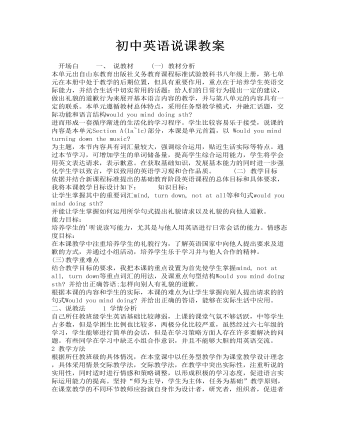
初中英语说课教案
(二) 教学目标 依据并结合新课程标准提出的基础教育阶段英语课程的总体目标和具体要求,我将本课教学目标设计如下: 知识目标: 让学生掌握其中的重要词汇mind, turn down, not at all等和句式would you mind doing sth? 并能让学生掌握如何运用所学句式提出礼貌请求以及礼貌的向他人道歉。

新人教版高中英语选修2Unit 4 Journey Across a Vast Land教学设计
当孩子们由父母陪同时,他们才被允许进入这个运动场。3.过去分词(短语)作状语时的几种特殊情况(1)过去分词(短语)在句中作时间、条件、原因、让步状语时,相当于对应的时间、条件、原因及让步状语从句。Seen from the top of the mountain (=When it is seen from the top of the mountain), the whole town looks more beautiful.从山顶上看,整个城市看起来更美了。Given ten more minutes (=If we are given ten more minutes), we will finish the work perfectly.如果多给十分钟,我们会完美地完成这项工作。Greatly touched by his words (=Because she was greatly touched by his words), she was full of tears.由于被他的话深深地感动,她满眼泪花。Warned of the storm (=Though they were warned of the storm), the farmers were still working on the farm.尽管被警告了风暴的到来,但农民们仍在农场干活。(2)过去分词(短语)在句中作伴随、方式等状语时,可改为句子的并列谓语或改为并列分句。The teacher came into the room, followed by two students (=and was followed by two students).后面跟着两个学生,老师走进了房间。He spent the whole afternoon, accompanied by his mom(=and was accompanied by his mom).他由母亲陪着度过了一整个下午。
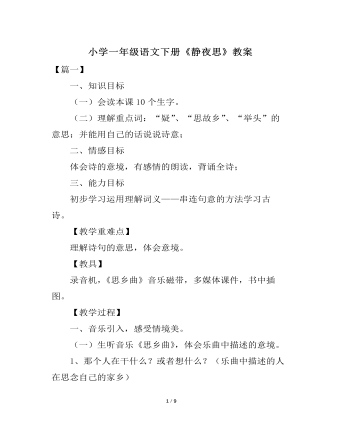
《静夜思》教案
(1)读整行诗。 (2)根据学生提出的问题理解“疑”的意思(怀疑、好像); “霜”(老师哈气在眼镜片上,并解释这是雾水,如果是冰粒,便是霜。霜在秋冬季节形成在地面附近:如房顶、草叶、地面等,堆起来是白色。) (3)说说这两行诗的意思。用上“什么好像是什么”的句式。(明亮的月光照在诗人的床前,好象是铺在地上的白白的霜) (4)朗读,引导。 诗人这样描写,给了你一种什么样的感觉?(冷清) 师描述:今晚,银白色的月光洒在地上,像铺了一层冰冷的霜一样。环境如此冷清,再加上诗人远离亲人的孤独,就更感到冷清了。
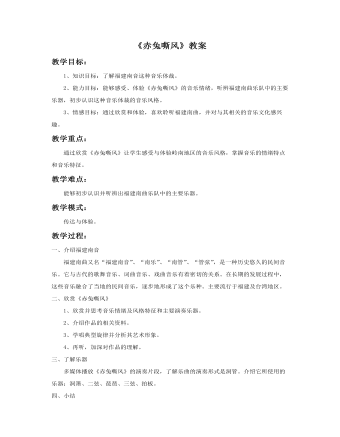
《赤兔嘶风》教案
一、介绍福建南音福建南曲又名“福建南音”、“南乐”、“南管”、“管弦”,是一种历史悠久的民间音乐。它与古代的歌舞音乐、词曲音乐、戏曲音乐有着密切的关系。在长期的发展过程中,这些音乐融合了当地的民间音乐,逐步地形成了这个乐种。主要流行于福建及台湾地区。二、欣赏《赤兔嘶风》1、欣赏并思考音乐情绪及风格特征和主要演奏乐器。2、介绍作品的相关资料。3、学唱典型旋律并分析其艺术形象。4、再听,加深对作品的理解。三、了解乐器多媒体播放《赤兔嘶风》的演奏片段,了解乐曲的演奏形式是洞管。介绍它所使用的乐器:洞箫、二弦、琵琶、三弦、拍板。
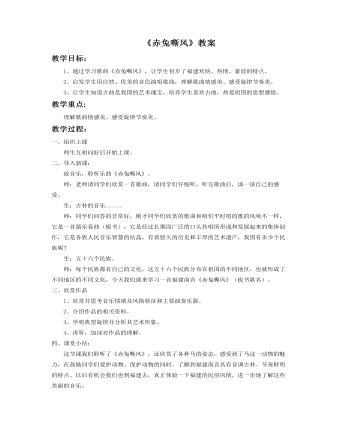
《赤兔嘶风》教案
教学目标:1、通过学习歌曲《赤兔嘶风》,让学生初步了福建欢快、热情、豪放的特点。2、启发学生用自然、优美的音色演唱歌曲;理解歌曲情感美、感受旋律节奏美。3、让学生知道古曲是我国的艺术瑰宝,培养学生喜欢古曲,热爱祖国的思想感情。这节课我们聆听了《赤兔嘶风》,还欣赏了各种马的姿态,感受到了马这一动物的魅力,在鼓励同学们爱护动物、保护动物的同时。了解到福建南音具有音调古朴、节奏鲜明的特点。以后有机会我们也到福建去,真正体验一下福建的民俗风情,进一步地了解这些美丽的音乐。
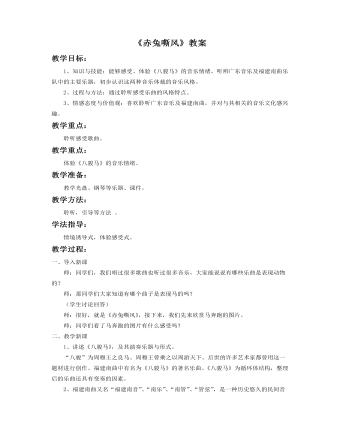
《赤兔嘶风》教案
一、导入新课师:同学们,我们唱过很多歌曲也听过很多音乐,大家能说说有哪些乐曲是表现动物的?师:那同学们大家知道有哪个曲子是表现马的吗?(学生讨论回答)师:很好,就是《赤兔嘶风》,接下来,我们先来欣赏马奔跑的图片。师:同学们看了马奔跑的图片有什么感受吗?二、教学新课1、讲述《八骏马》,及其演奏乐器与形式。 “八骏”为周穆王之良马。周穆王曾乘之以周游天下。后世的许多艺术家都曾用这一题材进行创作。福建南曲中有名为《八骏马》的著名乐曲。《八骏马》为循环体结构,整理后的乐曲还具有变奏的因素。2、福建南曲又名“福建南音”、“南乐”、“南管”、“管弦”,是一种历史悠久的民间音乐。它与古代的歌舞音乐、词曲音乐、戏曲音乐有着密切的关系。在长期的发展过程中,这些音乐融合了当地的民间音乐,逐步地形成了这个乐种。南曲包括了“指”、“谱”、“曲”三大部分。“指”是一种套曲;“谱”是有标题的器乐套曲;“曲”是有唱词的散曲,只唱不说。南曲的演奏形式有“上四管”、“下四管”之分。上四管以洞箫为主,叫做“洞管”;以笛子为主的叫做“品管”。
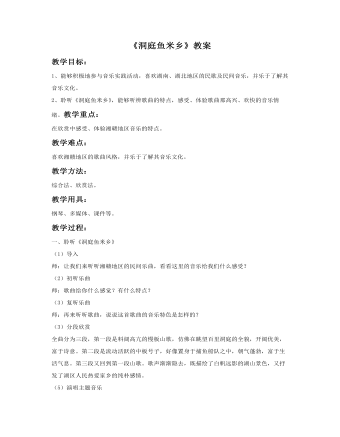
《洞庭鱼米乡》教案
一、聆听《洞庭鱼米乡》 (1)导入 师:让我们来听听湘赣地区的民间乐曲,看看这里的音乐给我们什么感受? (2)初听乐曲 师:歌曲给你什么感觉?有什么特点? (3)复听乐曲 师:再来听听歌曲,说说这首歌曲的音乐特色是怎样的?(3)分段欣赏全曲分为三段,第一段是料阔高亢的慢板山歌,仿佛在眺望百里洞庭的全貌,开阔优美,富于诗意。第二段是流动活跃的中板号子,好像置身于捕鱼船队之中,朝气蓬勃,富于生活气息。第三段又回到第一段山歌。歌声渐渐隐去,既描绘了白帆远影的湖山景色,又抒发了湖区人民热爱家乡的纯朴感情。(5)演唱主题音乐
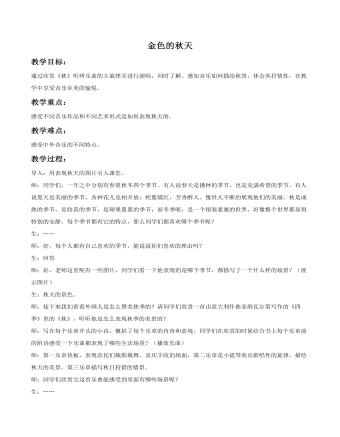
《秋》教案
导入:用表现秋天的图片引入课堂。师:同学们,一年之中分别有春夏秋冬四个季节。有人说春天是播种的季节,也是充满希望的季节,有人说夏天是美丽的季节。各种花儿竞相开放:姹紫嫣红,芳香醉人。像世人不断的展现他们的美丽,秋是成熟的季节,是收获的季节,是硕果累累的季节,而冬季呢,是一个银装素裹的世界,好像整个世界都显得特别的安静。每个季节都有它的特点,那么同学们都喜欢哪个季节呢?生:……师:好,每个人都有自己喜欢的季节,能说说你们喜欢的理由吗?生:回答师:好,老师这里呢有一些图片,同学们看一下他表现的是哪个季节,都描写了一个什么样的场景?(展示图片)生:秋天的景色。师:接下来我们看看外国人是怎么赞美秋季的?请同学们欣赏一首由意大利作曲家维瓦尔第写作的《四季》里的《秋》,听听他是怎么表现秋季的美景的?师:写在每个乐章开头的小诗,概括了每个乐章的内容和意境。同学们在欣赏的时候结合书上每个乐章前的附诗感受一下乐曲都表现了哪些生活场景?(播放乐曲)师:第一乐章快板,表现农民们载歌载舞、喜庆丰收的场面,第二乐章是小提琴奏出歌唱性的旋律,描绘秋天的美景。第三乐章描写秋日狩猎的情景。
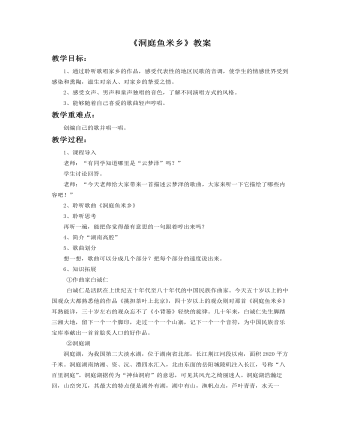
《洞庭鱼米乡》教案
知识拓展①作曲家白诚仁白诚仁是活跃在上世纪五十年代至八十年代的中国民族作曲家。今天五十岁以上的中国观众大都熟悉他的作品《挑担茶叶上北京》,四十岁以上的观众则对那首《洞庭鱼米乡》耳熟能详,三十岁左右的观众忘不了《小背篓》轻快的旋律。几十年来,白诚仁先生脚踏三湘大地,留下一个一个脚印,走过一个一个山寨,记下一个一个音符,为中国民族音乐宝库奉献出一首首脍炙人口的好作品。 ②洞庭湖洞庭湖,为我国第二大淡水湖,位于湖南省北部,长江荆江河段以南,面积2820平方千米。洞庭湖南纳湘、资、沅、澧四水汇入,北由东面的岳阳城陵矶注入长江,号称“八百里洞庭”。洞庭湖据传为“神仙洞府”的意思,可见其风光之绮丽迷人。洞庭湖浩瀚迂回,山峦突兀,其最大的特点便是湖外有湖,湖中有山,渔帆点点,芦叶青青,水天一色。
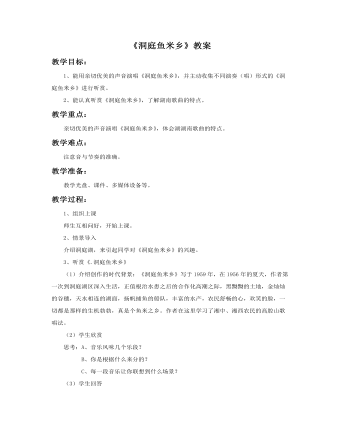
《洞庭鱼米乡》教案
教学过程:1、组织上课师生互相问好,开始上课。2、情景导入介绍洞庭湖,来引起同学对《洞庭鱼米乡》的兴趣。3、听赏《.洞庭鱼米乡》(1)介绍创作的时代背景:《洞庭鱼米乡》写于1959年,在1956年的夏天,作者第一次到洞庭湖区深入生活,正值根治水患之后的合作化高潮之际,黑黝黝的土地,金灿灿的谷穗,天水相连的湖面,扬帆捕鱼的船队,丰富的水产,农民舒畅的心,欢笑的脸,一切都是那样的生机勃勃,真是个鱼米之乡。作者在这里学习了湘中、湘西农民的高腔山歌唱法。(2)学生欣赏思考:A、音乐风味几个乐段?B、你是根据什么来分的?C、每一段音乐让你联想到什么场景?(3)学生回答

《曼德》教案
一、导入引导学生观看电影中的歌舞片段。导入对印度音乐文化的介绍。二、新课学习1. 印度的歌舞。教师:从影片中我们感受到印度的歌、乐、舞融合得非常紧密。所以,我们先来了解一下印度的歌舞。(1)介绍印度的舞蹈分为:古典舞、民族舞和流行歌舞。而以宝莱坞为代表的印度电影音乐,多为流行歌舞的范畴。而印度最具代表性的舞蹈当属古典舞。(2)观察印度古典舞的九种面部表情。请学生尝试分辨出哪一个是“爱”的表情。学生选择后(答案为左上第一幅图),教师小结:由于文化的不同,不同国家的人们对包括表情在内的许多事物会有不同的含义与理解。(3)请学生随录像(最好由教师亲自示范录像中: “身体健康、万事如意!”这一句),请学生模仿手语,传达相互的问候。
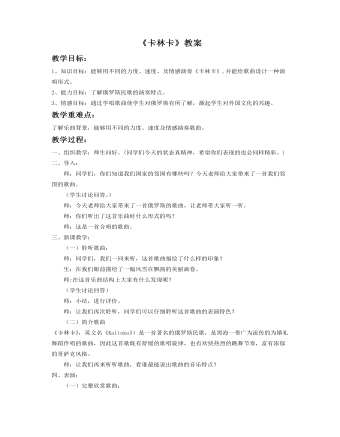
《卡林卡》教案
教学过程:一、组织教学:师生问好。(同学们今天的状态真精神,希望你们表现的也会同样精彩。)二、导入:师:同学们,你们知道我们国家的邻国有哪些吗?今天老师给大家带来了一首我们邻国的歌曲。(学生讨论回答。)师:今天老师给大家带来了一首俄罗斯的歌曲,让老师带大家听一听。师:你们听出了这首乐曲时什么形式的吗? 师:这是一首合唱的歌曲。三、新课教学: (一)聆听歌曲: 师:同学们,我们一同来听,这首歌曲描绘了什么样的印象? 生:在我们眼前描绘了一幅风雪在飘扬的美丽画卷。师:在这首乐曲结构上大家有什么发现呢?(学生讨论回答) 师:小结,进行评价。 师:让我们再次聆听,同学们可以仔细聆听这首歌曲的表演特色?
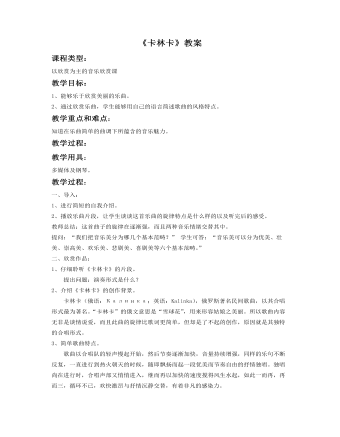
《卡林卡》教案
一、导入:1、进行简短的自我介绍。2、播放乐曲片段,让学生谈谈这首乐曲的旋律特点是什么样的以及听完后的感受。教师总结:这首曲子的旋律在逐渐强,而且两种音乐情绪交替其中。提问:“我们把音乐美分为哪几个基本范畴?” 学生可答:“音乐美可以分为优美、壮美、崇高美、欢乐美、悲剧美、喜剧美等六个基本范畴。”二、欣赏作品:1、仔细聆听《卡林卡》的片段。 提出问题:演奏形式是什么?2、介绍《卡林卡》的创作背景。卡林卡(俄语:Калинка;英语:Kalinka),俄罗斯著名民间歌曲,以其合唱形式最为著名。“卡林卡”的俄文意思是“雪球花”,用来形容姑娘之美丽。所以歌曲内容无非是谈情说爱,而且此曲的旋律比歌词更简单,但却是了不起的创作,原因就是其独特的合唱形式。
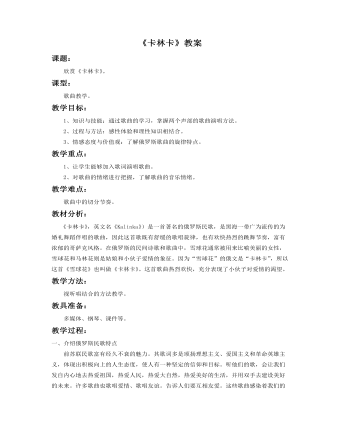
《卡林卡》教案
教学重点:1、让学生能够加入歌词演唱歌曲。2、对歌曲的情绪进行把握,了解歌曲的音乐情绪。教学难点:歌曲中的切分节奏。教材分析:《卡林卡》,英文名《Kalinka》)是一首著名的俄罗斯民歌,是黑海一带广为流传的为婚礼舞蹈伴唱的歌曲,因此这首歌既有舒缓的歌唱旋律,也有欢快热烈的跳舞节奏,富有浓郁的哥萨克风格。在俄罗斯的民间诗歌和歌曲中,雪球花通常被用来比喻美丽的女性,雪球花和马林花则是姑娘和小伙子爱情的象征。因为“雪球花”的俄文是“卡林卡”,所以这首《雪球花》也叫做《卡林卡》。这首歌曲热烈欢快,充分表现了小伙子对爱情的渴望。